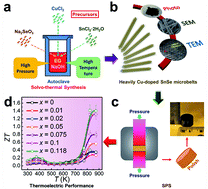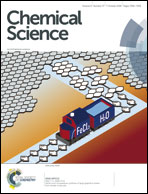Boosting the thermoelectric performance of p-type heavily Cu-doped polycrystalline SnSe via inducing intensive crystal imperfections and defect phonon scattering†
Abstract
In this study, we, for the first time, report a high Cu solubility of 11.8% in single crystal SnSe microbelts synthesized via a facile solvothermal route. The pellets sintered from these heavily Cu-doped microbelts show a high power factor of 5.57 μW cm−1 K−2 and low thermal conductivity of 0.32 W m−1 K−1 at 823 K, contributing to a high peak ZT of ∼1.41. Through a combination of detailed structural and chemical characterizations, we found that with increasing the Cu doping level, the morphology of the synthesized Sn1−xCuxSe (x is from 0 to 0.118) transfers from rectangular microplate to microbelt. The high electrical transport performance comes from the obtained Cu+ doped state, and the intensive crystal imperfections such as dislocations, lattice distortions, and strains, play key roles in keeping low thermal conductivity. This study fills in the gaps of the existing knowledge concerning the doping mechanisms of Cu in SnSe systems, and provides a new strategy to achieve high thermoelectric performance in SnSe-based thermoelectric materials.

- This article is part of the themed collections: Tin Collection – a celebration of our 10th anniversary, Most popular 2018-2019 materials chemistry articles and Most popular 2018-2019 energy articles


 Please wait while we load your content...
Please wait while we load your content...